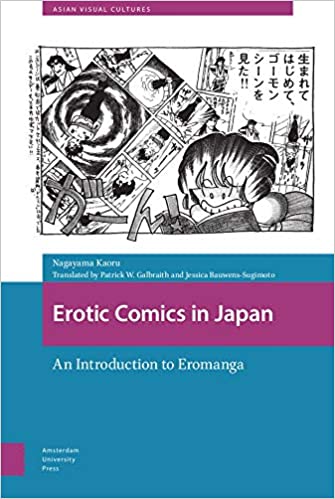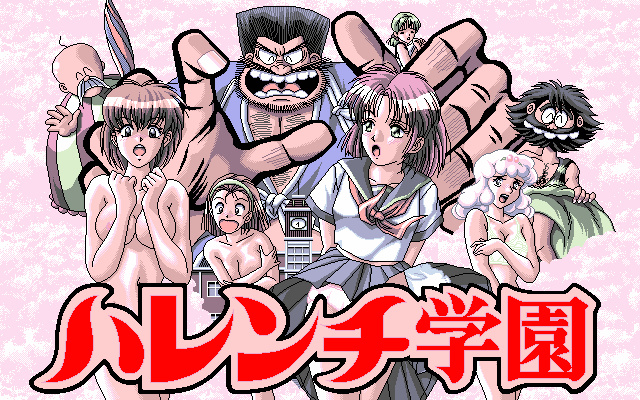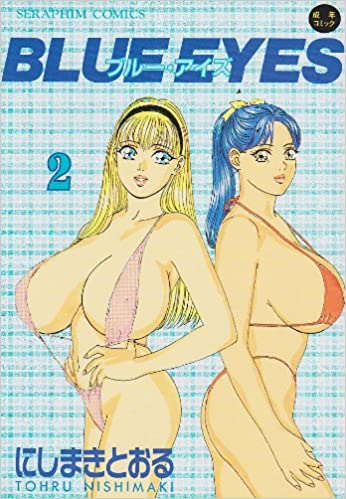Books: Erotic Comics in Japan
November 23, 2020 · 0 comments
By Jonathan Clements.
 This review is definitely Not Suitable For Work. Kaoru Nagayama’s Erotic Comics in Japan: An Introduction to Eromanga, in fact, comes loaded with so many explicit images, often of a frankly triggering nature, that I am unsurprised it is not only published at a weeb-scaringly high price, but by a university press in the famously tolerant Netherlands. Nagayama presents a history of the development of erotic manga, and a run-down of its many variant niches, sure to prove eye-poppingly illuminating to contemporary scholars. It will be of particular value to non-Japanese researchers in the field of comics studies unsure of how to visualise such a wide field in a country that is foreign to them.
This review is definitely Not Suitable For Work. Kaoru Nagayama’s Erotic Comics in Japan: An Introduction to Eromanga, in fact, comes loaded with so many explicit images, often of a frankly triggering nature, that I am unsurprised it is not only published at a weeb-scaringly high price, but by a university press in the famously tolerant Netherlands. Nagayama presents a history of the development of erotic manga, and a run-down of its many variant niches, sure to prove eye-poppingly illuminating to contemporary scholars. It will be of particular value to non-Japanese researchers in the field of comics studies unsure of how to visualise such a wide field in a country that is foreign to them.
The book is a translation not only of Nagayama’s original 2006 book, but of its 2014 re-issue, which added an extra chapter on, among other things, the controversially restrictive Bill 156. Opposition to this 2010 piece of legislation was entertainingly diverse, as were its targets. In one incident that ably demonstrated the dangerously broad remit of its crusade against “harmful” works, one Japanese politician tried to use it to ban Winnie the Pooh.
 There’s a double hurdle for many Japanese studies authors to clear. Firstly, there’s getting translated in the first place, since overseas peers are sure to win more points on the tenure track by writing their own books instead of translating someone else’s. Then there’s the issue of who gets translated – the translators’ introduction notes that much of Nagayama’s work is effectively “outside” the academy. This is a researcher of indubitable pedigree, who goes the extra mile by actually setting up a table to sell his wares at Comiket. In fact, he often shares his dealer’s table with Rito Kimi, a fellow researcher whose own history of erotic manga was itself the subject of a local clampdown in 2018, accusing it of corrupting the young! So, according to some Japanese law-makers, even reading this review might prove mind-bendingly dangerous to you. Don’t say you weren’t warned.
There’s a double hurdle for many Japanese studies authors to clear. Firstly, there’s getting translated in the first place, since overseas peers are sure to win more points on the tenure track by writing their own books instead of translating someone else’s. Then there’s the issue of who gets translated – the translators’ introduction notes that much of Nagayama’s work is effectively “outside” the academy. This is a researcher of indubitable pedigree, who goes the extra mile by actually setting up a table to sell his wares at Comiket. In fact, he often shares his dealer’s table with Rito Kimi, a fellow researcher whose own history of erotic manga was itself the subject of a local clampdown in 2018, accusing it of corrupting the young! So, according to some Japanese law-makers, even reading this review might prove mind-bendingly dangerous to you. Don’t say you weren’t warned.
Nagayama is one of the lucky ones, in the hands of Patrick W. Galbraith and Jessica Bauwens-Sugimoto, both big in the field of writing on manga and erotica, his work is not only given the chance to shine, but discreetly buffed up to be a little better than it originally was. In an excellent introduction that situates Nagayama’s work within more recent studies and arguments, Galbraith and Bauwens-Sugimoto reveal themselves to be kindred spirits, eagerly embracing his concept of the “erotic barrier” (ero no kabe, redolent of the “idiot wall” proposed by Yasutaka Tsutsui) – a notional barrier of ignorance or prurience that prevents so many critics from appreciating the genuine diversity of manga erotica. The subject, they complain, only comes up when people are trying to prohibit something monstrous, or to decry something they find disgusting, and there is rarely any discussion of the mountains of consensual, happy smut, by and for men and women, catering to all ages and tastes. They have plainly undertaken work on this book as an exercise in broadening academia’s understanding of what is out there, in the hope that future scholars will not write off entire sectors of the Japanese publishing world with nothing but a one-line dismissal of Lolicon.
Kirsten Cather has previously written about some of the intrigues of Japanese censorship. As the translators point out, later trials mentioned here, sometimes featuring the same lawyers, function as a sort of sequel to her book, bringing it up to date with coverage of the Rokudenashi scandal, in which artist Megumi Igarashi was censured for paddling her own canoe. Her infamous kayak got all the attention in the media, but few commentators noted that part of Igarashi’s navel-gazing (well, it wasn’t her navel…) art project included a manga on the same subject, which was one of the early casualties of the media backlash.
Nagayama is on hand with hard facts. Not for him the airy, hand-waving of both pro- and anti- erotica journalists, ready to claim that it’s taking the world by storm. No, the average eromanga print-run is a healthy but minor 10,000 copies, with the really big-name authors climbing up to 50,000. Nagayama’s prime focus is erotic manga since the 1980s, but he begins with chapters on the genre’s history, placing it in context as a subversion of mainstream imagery. Sometimes, he argues, that mainstream imagery was all too aware of its likely “abuse” – he cites, in particular, the overt sexualisation of Tinkerbell in Disney’s Peter Pan (1953, released in Japan in 1955) and some of the erotic undertones of early Tezuka. He argues for the long-term influence of the 1960s avant-garde magazines Garo and COM, chiefly because they were “ungendered”, and did not see themselves as being either by or for one particular sex. Go Nagai is a bawdy pioneer with his notorious Shameless School (1967, the game spin-off is illustrated below), before pursing Sadean extremes in Violence Jack (1973) – and Nagayama relates the outrageous story that Nagai’s excesses were kept “fantastic” by a managing editor enforcing compulsory celibacy on the artist, all the better to make sure that no unwelcome realism crept in!
 Nagayama depicts the 1970s as a slough of despondency, as the bright young things of the 1960s student protests see their dreams shattered and their economy slumping (imagine Brexit, in the middle of a global crisis… oh, wait…). He cocks a wry snook at the mainstream critical excitement over Takashi Ishii’s Angel Guts (1972), which he regards as the tardy recognition of clueless dilettantes, before moving onto the “third-rate gekiga” of the mid-1970s. This is not his term but that of the Japanese media, which regarded the eroticisation of manga for adults as some sort of moral failure. The first Comiket comic market is held in 1975, creating a new environment for dissent and experimentation.
Nagayama depicts the 1970s as a slough of despondency, as the bright young things of the 1960s student protests see their dreams shattered and their economy slumping (imagine Brexit, in the middle of a global crisis… oh, wait…). He cocks a wry snook at the mainstream critical excitement over Takashi Ishii’s Angel Guts (1972), which he regards as the tardy recognition of clueless dilettantes, before moving onto the “third-rate gekiga” of the mid-1970s. This is not his term but that of the Japanese media, which regarded the eroticisation of manga for adults as some sort of moral failure. The first Comiket comic market is held in 1975, creating a new environment for dissent and experimentation.
Amidst all this excitement, he centres the influence of the Magnificent 49ers, that group of female artists who not only transformed comics for girls, but, as Nagayama relates, proved to be a game-changing inspiration to the creators of erotica. He also points to the iconic Lum of Urusei Yatsura, the first of a whole menagerie of Rumiko Takahashi love-comedy temptresses that, he provocatively points out, were effectively clad in fetish gear.
With his third chapter, Nagayama gets to the revolution in “Lolita Complex” erotica in the 1980s, which he relates to an incipient sense of Generation X fragility, a backlash against the worker-ant machismo of the 1970s. Like Yasuo Nagayama (no relation), he charts another revolution behind the scenes, as the otaku start to take over conventions and publishing, privileging comics and anime, and shunting aside prose fiction.
“Gone is the pathos of third-rate gekiga,” he writes. “In its place is an artificial body, deodorized and without the smell of sweat, a ‘character’ [chara] shaded as if on animation celluloid.” It’s here, as erotic manga finally gets big, that it becomes noticeable enough to attract the attention of the authorities, a story that has been ably told elsewhere, particularly in Debating Otaku in Contemporary Japan (reviewed here on this blog). Here, Nagayama gets entertainingly picky with the media backlash, asking if the anti-Lolicon crusades were really aimed at erotic manga that could be read by children, or at erotic manga that seemingly featured children. He calculates, on the basis of his own observations of disappearing titles, that the business must have lost 1.2 billion yen during one of the 1990s clampdowns alone.
 The second half of Nagayama’s book is an anatomy of the many sectors of erotic manga publishing, highlighting specific genres throughout the last few decades. This is certainly useful for getting a sense of the diversity within the field, although I do not necessarily agree with all his analyses, explanations or canonical choices. Nor, I suspect, do his translators, since there are several occasions where they crowd into the footnotes to offer elucidation and mitigation. As I have occasionally observed, often to angry retorts from academia, there are certain elements of manga studies that are wildly over-represented abroad, and several of them – BDSM, Lolicon, Boys’ Love – are already well known to overseas researchers.
The second half of Nagayama’s book is an anatomy of the many sectors of erotic manga publishing, highlighting specific genres throughout the last few decades. This is certainly useful for getting a sense of the diversity within the field, although I do not necessarily agree with all his analyses, explanations or canonical choices. Nor, I suspect, do his translators, since there are several occasions where they crowd into the footnotes to offer elucidation and mitigation. As I have occasionally observed, often to angry retorts from academia, there are certain elements of manga studies that are wildly over-represented abroad, and several of them – BDSM, Lolicon, Boys’ Love – are already well known to overseas researchers.
Nagayama deals with the well-trodden ground of “Lolita Complex”, which, as with the word otaku in translator Patrick Galbraith’s book on the subject, turns out not to mean quite the same thing all the time as everybody thought it did. In a far more ground-breaking chapter, he moves onto Big Boobs manga, although I am a trifle disappointed that he didn’t think to apply his penchant for metadata to examining the evidence of changing breast sizes in Japanese society. His touchstone is Tohru Nishimaki’s Blue Eyes, in which a lucky Japanese youth gets to be intimate, at first with the buxom half-English girl Maria, and then with Maria’s similarly well-endowed family and friends.
I would have liked to have seen a deeper discussion of race and occidentalism here. Nagayama points in particular to the inspiration provided by Christina Jane Small (a.k.a. Titanic Tina), the Somerset stunner who is literally big in Japan, having a Japanese Wikipedia page, but no presence on the English equivalent. I confess, despite having a public interest in cross-cultural influences, that I had never heard of Ms Small before reading this book, which is precisely the sort of ignorance Nagayama’s book hopes to dispel. Small’s inadvertent role as Nishimaki’s muse in Blue Eyes, is surely only the tip of the iceberg when it comes to such things – one day, when there is enough metadata in the Cloud, I am sure that someone will be able to write a history of comics light-boxing, incorporating the many erotic images and hidden connections lifted from live-action photoshoots.
Nagayama himself notes that the boobs on display in Blue Eyes and similar manga are so hypertrophic as to be beyond the capabilities of bra engineering. Here, again, I think he could have pursued another direction, relating these overblown organs to similar gigantism (admittedly, not of breasts) to be found in pornographic woodblock printed books of the Edo era. It has been suggested that such occurrences in Tokugawa-period erotica are often impressionistic concentrations – a sort of in-picture zoom on the bits that matter most, if you like, but this is a subject that Nagayama does not pursue. I fear either it has not occurred to him, or that he is over-compensating for earlier authors who insisted on relating everything to olden times, in a misguided attempt to make manga seem part of a longer historical continuum. Here, for once, it might have been a relevant angle.
Nagayama’s next chapter covers incest manga. While it serves as an effective introduction to the genre, I can’t help but feel he is again missing a couple of historical parallels, particularly regarding adoptive heirs, that would have been worth bringing up. Another chapter deals with “Disgrace and Training”, and here I notice an increasing number of translators’ notes bolstering Nagayama’s work with productive links to research elsewhere. I find such after-care commendable, effectively allowing Nagayama to engage, in a manner of speaking, with a number of works that he has presumably yet to read himself, carrying his own conclusions further than they might otherwise have gone. He is, as they have already admitted, “outside the academy”, and it’s here that the lack of true peer review would have shown him up. In that regard, they are not merely his translators, but also his able research assistants.
Nagayama has a far more nuanced understanding of contexts and fore-runners in his chapter on Sadomasochism – there is, for example, a note on the work of Shozo Numa, and the suggestion that much of Japan’s post-war history has been an exercise in domination. Another chapter on Gender Mayhem, specifically related to the swapping around of sexual organs, was sadly written before the “Boys in Skirts” phenomenon of the 2010s, which, as I have argued elsewhere, may not have been a phenomenon at all, except as an exercise in getting around the very censorship restrictions that Nagayama has mentioned. This does, however, get a little nod in the book’s 2014 epilogue.
 Nagayama’s concentration on rape, incest, and BDSM risks perpetuating the very biases that he was trying to fight, since absolutely scads of “manga erotica” are so plain vanilla, or at least run-of-the-mill, that they rarely attract the attention of critics or pundits wanting to be shocked. My own readings for Manga Snapshot, for which I deconstruct a different manga anthology magazine each month, have uncovered all sorts of intriguing erotica, including sex comedies for singletons, first-person perspective romances, where the female implied-reader is sent off on dates with a boyfriend that addresses her directly, and anthologies devoted to sex within marriage. In other words, there is an area where erotica fades into plain yet still X-rated passion, particularly in the adult women’s market, and while Nagayama does eventually touch on these issues, his chapter on Romance does feel a little half-hearted; nor does he accord it a page-count concomitant with its size within the industry. There are some indications here of key titles, but I couldn’t help feeling that he has a somewhat lesser grasp of erotica that is actually aimed at women, such as, say, the happy humping of Love Report Pastel magazine or the explicit office-lady affairs of Young Love Comic Aya (pictured). Similarly, although same-sex erotica do get some coverage, I was surprised to see that there was no separate chapter on specifically “vanilla” gay or lesbian manga – the word “lesbian”, in fact, only crops up nine times in the whole book, despite the existence of whole magazines on the subject, like the wonderfully even-handed and inclusionist Yurihime. These days, he would be expected to have a little more consideration for the female gaze.
Nagayama’s concentration on rape, incest, and BDSM risks perpetuating the very biases that he was trying to fight, since absolutely scads of “manga erotica” are so plain vanilla, or at least run-of-the-mill, that they rarely attract the attention of critics or pundits wanting to be shocked. My own readings for Manga Snapshot, for which I deconstruct a different manga anthology magazine each month, have uncovered all sorts of intriguing erotica, including sex comedies for singletons, first-person perspective romances, where the female implied-reader is sent off on dates with a boyfriend that addresses her directly, and anthologies devoted to sex within marriage. In other words, there is an area where erotica fades into plain yet still X-rated passion, particularly in the adult women’s market, and while Nagayama does eventually touch on these issues, his chapter on Romance does feel a little half-hearted; nor does he accord it a page-count concomitant with its size within the industry. There are some indications here of key titles, but I couldn’t help feeling that he has a somewhat lesser grasp of erotica that is actually aimed at women, such as, say, the happy humping of Love Report Pastel magazine or the explicit office-lady affairs of Young Love Comic Aya (pictured). Similarly, although same-sex erotica do get some coverage, I was surprised to see that there was no separate chapter on specifically “vanilla” gay or lesbian manga – the word “lesbian”, in fact, only crops up nine times in the whole book, despite the existence of whole magazines on the subject, like the wonderfully even-handed and inclusionist Yurihime. These days, he would be expected to have a little more consideration for the female gaze.
In erotica, as so many other things, size really does matter, and I was left wishing for a pie chart or two that could make clear just how small (or large) some of these genre niches are, as well as how their readerships might have fluctuated over the years. But publishers are reluctant to give much away, and Nagayama’s own ad hoc calculations, taking into account his own experience in distribution, and the 10,000-copy cut-off point for statistical relevance in the Japanese Magazine Publishers Association, are certainly convincing enough for now. In the years since Nagayama’s original publication, however, I am curious as to what he would make of the sort of statistics occasionally released by the likes of Pornhub, about which nationalities search for what particular porn most often. It would have made for an interesting comparison with his decisions over which manga to favour.
The last forty pages of the book bring the original 2006 edition up to date for its 2014 reprint. Inevitably, much of the focus is on reportage of the “harmful media” backlash in Japan during the 2010s, the impact of the internet, gaming and digital publishing. As Nagayama admits in his afterword, in 2006, “I thought that I had written what needed to be written. I wrote what I wanted to write.” The resultant book is a powerful and occasionally startling glimpse at aspects of the erotic manga industry, but it is still a glimpse – there is rarely much space for Nagayama to discuss particular titles in depth, and single moments in one-shot stories can sometimes receive more attention than sagas that run for years. This book will undoubtedly serve as a useful primer for researchers wading into the minefield of Japanese erotica, and offers many trenchant and thought-provoking observations. The reader, however, will often have to bring their own sense of both cultural and intercultural context and proportion.
Jonathan Clements is the author of Anime: A History and has been writing the Manga Snapshot column in NEO magazine since 2005. Erotic Comics in Japan: An Introduction to Eromanga is published in English by Amsterdam University Press.
Leave a Reply